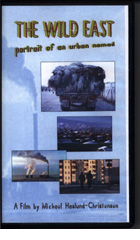
The Wild East: Portrait of an Urban Nomad 2002
Distributed by First Run/Icarus Films, 32 Court St., 21st Floor, Brooklyn, NY 11201; 800-876-1710
Produced by Haslund Films and the Danish Film Institute
Directed by Michael Haslund-Christensen
VHS, color, 54 min.
Sr. High - Adult
Asian Studies, Social Studies
Date Entered: 11/09/2018
Reviewed by Cliff Glaviano, Coordinator of Cataloging, Bowling Green State University Libraries, Bowling Green, OHThis documentary provides insight into the socioeconomic effects of the relatively recent shift from Soviet-style socialism to capitalism on the lives of the citizens of Mongolia. Though the film chiefly chronicles the efforts of the young adult friends, Sasha and Jenya, to find some kind of lasting, gainful employment in Ulan Bator, Mongolia’s capital and largest city, it also provides commentary on the enormous changes wrought on the lives of other generations and on rural populations. Though the withdrawal of Soviet support in the early 1990’s and capitalist economic reform of 1995 produced great poverty in Mongolia, the current situation is compounded by a crumbling urban infrastructure and the growth of the tent and shanty cities the starving rurals have built looking for economic relief in the city. There no longer is a future for Mongolia’s working class and there’s little relief from government or international organizations in sight.
The quality of the audio and video is excellent. Sasha’s English is outstanding and subtitles for the Mongol and Russian exchanges are well done. The photography and editing are first-rate, giving a good flow to a story that could have been quite disjointed. There’s also a bit of directorial and cinematographic magic going on: not a hint of any camera-shyness by any of the subjects in this film, and as impossible as it may seem, no hint by those being filmed that they are aware that the camera is on them. This is quite an achievement given the diverse locations (family interior shots to outdoor crowd interactions) of the action.
This film will enhance Asian collections in college and university libraries. It can serve as a stimulus in any discussion on world societies, capitalism, or the political and social impacts from the deconstruction of the former Soviet Union. There are problems touched on in this film that should raise serious moral and ethical questions concerning the American way of life and the role of our government in sharing its wealth internationally. For in-depth coverage of a different perspective on Mongolia’s dire economic situation, please see Ulan Bator: The Children From Underground (Mongolia).